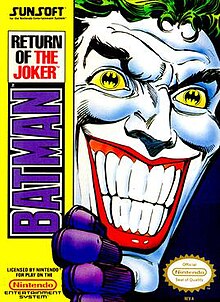
The Super Nintendo Entertainment System, commonly shortened to Super Nintendo, Super NES or SNES, is a 16-bit home video game console developed by Nintendo that was released in 1990 in Japan and South Korea, 1991 in North America, 1992 in Europe and Oceania and 1993 in South America. In Japan, it is called the Super Famicom (SFC). In South Korea, it is called the Super Comboy and was distributed by Hyundai Electronics. The system was released in Brazil on August 30, 1993, by Playtronic. Although each version is essentially the same, several forms of regional lockout prevent cartridges for one version from being used in other versions.

Wonder Boy in Monster Land, known by its original arcade release as Wonder Boy: Monster Land, is a platform video game developed by Westone Bit Entertainment and released by Sega in Japanese arcades in 1987 and for the Master System in 1988, with a number of other home computer and console ports following. The game is the sequel to the 1986 game Wonder Boy and takes place eleven years after the events in the previous game. After enjoying over a decade of peace on Wonder Land following the defeat of the evil King by Tom-Tom, later bestowed the title "Wonder Boy", a fire-breathing dragon called the MEKA dragon appeared; he and his minions conquered Wonder Land, turning it into "Monster Land". The people, helpless due to their lack of fighting skill, call for Wonder Boy, now a teenager, to destroy the monsters and defeat the MEKA dragon. Players control Wonder Boy through twelve linear levels as he makes his way through Monster Land to find and defeat the MEKA dragon. Players earn gold by defeating enemies and buy weapons, armor, footwear, magic, and other items to help along the way.
In the history of video games, the fourth generation of video game consoles, more commonly referred to as the 16-bit era, began on October 30, 1987, with the Japanese release of NEC Home Electronics' PC Engine. Though NEC released the first console of this era, sales were mostly dominated by the rivalry between Sega and Nintendo across most markets: the Sega Mega Drive and the Super Nintendo Entertainment System. Cartridge-based handheld consoles became prominent during this time, such as the Nintendo Game Boy (1989), Atari Lynx (1989), Sega Game Gear (1990) and TurboExpress (1990).

Battletoads is a platform beat 'em up developed by Rare and published by Tradewest. It is the first installment of the Battletoads series and was originally released in June 1991 for the Nintendo Entertainment System. It was subsequently ported to the Mega Drive and Game Gear in 1993, to the Amiga and Amiga CD32 in 1994, and released with some changes for the Game Boy in 1993 in the form of Battletoads in Ragnarok's World. In the game, three space humanoid warrior toads form a group known as the Battletoads. Two of the Battletoads, Rash and Zitz, embark on a mission to defeat the evil Dark Queen on her planet and rescue their kidnapped friends: Pimple, the third member of the Battletoads, and Princess Angelica.
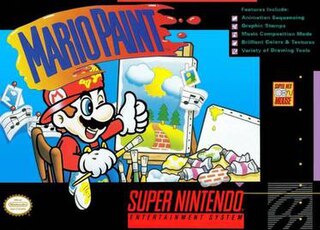
Mario Paint is a 1992 art creation video game developed by Nintendo Research & Development 1 (R&D1) and Intelligent Systems and published by Nintendo for the Super Nintendo Entertainment System. Mario Paint consists of a raster graphics editor, an animation program, a music composer, and a point and click minigame, all of which are designed to be used with the Super NES Mouse peripheral, which the game was packaged and sold with. Per its name, the game is Mario-themed, and features sprites and sound effects that are taken from or in the vein of Super Mario World.
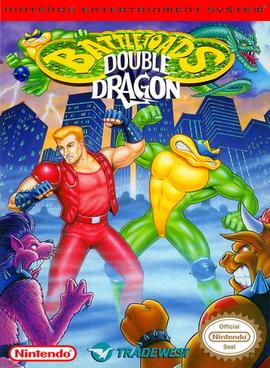
Battletoads/Double Dragon is a 1993 beat 'em up developed by Rare and published by Tradewest. It was originally released for the Nintendo Entertainment System and later ported to the Mega Drive/Genesis, Super NES, and Game Boy. Retro-bit Publishing has re-released the 8-bit NES version in early 2022 with plans to release the 16-bit versions later this year.

Gunstar Heroes is a run and gun video game developed by Treasure and published by Sega. It was Treasure's debut game, originally released for the Sega Genesis in 1993. The game's premise is centered around a pair of characters, the Gunstars, in their efforts to stop an evil empire from recovering four powerful gems. The characters can fire guns and perform a series of acrobatic maneuvers to fight enemies across each stage. There are four weapons in the game which can be combined with one another to create different shot types.

Snake Rattle 'n' Roll is a platform video game developed by Rare. It was published by Nintendo and released for the Nintendo Entertainment System in North America in July 1990 and in Europe on March 27, 1991. The game features two snakes, Rattle and Roll, as they make their way through eleven 3D isometric levels. A Mega Drive version was released by Sega in June 1993 with an extra level. Snake Rattle 'n' Roll was developed by Rare members Tim Stamper and Mark Betteridge. The music was composed by David Wise and was inspired by "Shake, Rattle and Roll" and other 1950s-era songs.

Wonder Boy III: The Dragon's Trap, known as Monster World II in Japan, is a platforming action-adventure video game developed by Westone as part of Sega's Wonder Boy series. It was published by Sega and released for the Master System in 1989 and for the Game Gear in 1992 as Wonder Boy: The Dragon's Trap. It was ported by Hudson Soft and released in 1991 for the TurboGrafx-16/PC Engine under the name Dragon's Curse. It was also ported in 1993 by Brazilian company Tec Toy under the title Turma da Mônica em o Resgate, with the game retooled to include characters from Brazilian comic book series Monica's Gang. A remake developed by Lizardcube and published by DotEmu, titled Wonder Boy: The Dragon's Trap, was released in April 2017.

Sonic the Hedgehog 2 is a 1992 platform game developed by Aspect and published by Sega for the Master System and Game Gear. It is the sequel to the 8-bit Sonic the Hedgehog (1991) and follows Sonic as he attempts to get the Chaos Emeralds back to rescue his friend Miles "Tails" Prower from Dr. Robotnik. Like the first Sonic the Hedgehog, players run through levels at high speeds while collecting rings and defeating enemies. Although it shares the same title with Sonic the Hedgehog 2 for the Sega Genesis and their releases coincided, the games have little in common and share no levels.
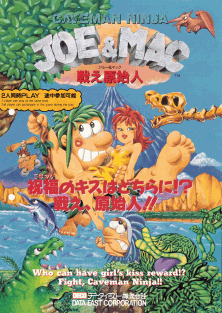
Joe & Mac, also known as Caveman Ninja and Caveman Ninja: Joe & Mac, is a run and gun platform game released as an arcade video game by Data East in 1991. It was adapted for the Super NES, Mega Drive/Genesis, Nintendo Entertainment System, Game Boy, Amiga, Zeebo, Nintendo Switch, and IBM PC compatibles.
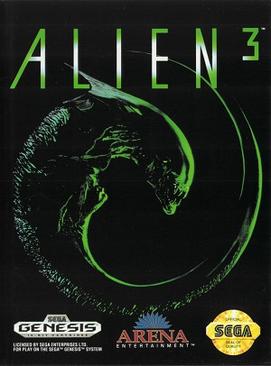
Alien 3 is a run and gun game based on the 1992 film of the same name. It was released for the Genesis and Amiga in 1992, then for the Commodore 64, Game Boy, Game Gear, Nintendo Entertainment System, Super Nintendo Entertainment System, and Master System.

The Adventures of Batman & Robin is a series of video game adaptations released between 1994 and 1995 featuring the DC Comics characters Batman and Robin based on Batman: The Animated Series. The games were released for numerous platforms, with the Genesis, Game Gear, and Sega CD versions published by Sega while the Super NES version was published by Konami.

The Addams Family is a platform game based on the 1991 film of the same name and developed and published by Ocean Software. It was released for home consoles such as the Super Nintendo Entertainment System, computers such as the Amiga, and handheld consoles like the Game Boy.
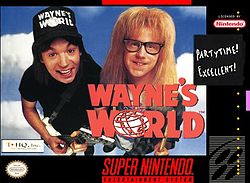
Wayne's World is an action video game based on the film of the same name and released in 1993 by THQ. Different versions of the game were released; the NES and Game Boy games were developed by Radical Entertainment and feature both protagonists Wayne and Garth as playable characters. The Super NES and Sega Mega Drive/Genesis games were developed by Gray Matter and feature only Wayne as a playable character.

Batman: The Video Game is a platform game developed by Sunsoft for the Nintendo Entertainment System, loosely based on the 1989 film Batman. The game contains five levels culminating in a showdown with the Joker in the bell tower of Gotham Cathedral. It was received well.
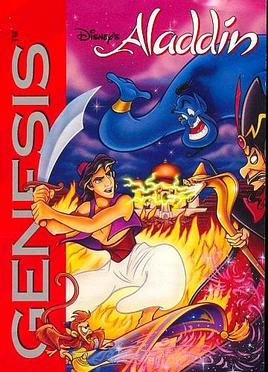
Disney's Aladdin is a platform game based on the 1992 film of the same name developed by Virgin Games USA. The game was released by Sega for the Sega Genesis on November 11, 1993 as one of several games based on the film, including another game that was released in the same month by Capcom for the Super NES.

Micro Machines is a racing game developed by Codemasters and originally published by Camerica for the Nintendo Entertainment System in 1991. Themed around Galoob's Micro Machines toys, players race in miniaturised toy vehicles around various environments. The game is the first installment in the Micro Machines video game series.

Terminator 2: Judgment Day is an action game released for several 8-bit consoles, including the Nintendo Entertainment System (NES), and Sega's Game Gear and Master System. It is based on the 1991 film of the same name. The NES version was developed by Software Creations and published by LJN in February 1992. The Sega versions were published in late 1993, by Flying Edge.

Batman Returns is a 1993 beat 'em up video game developed and published by Konami for the Nintendo Entertainment System. Based on the DC Comics superhero Batman, it is inspired by the Warner Bros.'s 1992 film of the same name. In the main storyline, Batman must confront both Catwoman and the Penguin.
